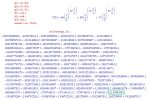I have a real world math problem that's way out of my league. I'm hoping somebody can push me in the right direction.
People with hemophilia have to regularly inject a protein to help their blood clot. As soon as it's injected it begins to decay. The level in the blood at time T is given by: Level=Q*(1/2)^(T/h) . There's a test to measure the level, and it's easy to solve for h:
h=T/log2(Q/Level)
The complication is that many people do multiple injections within a few half life cycles, so the Level is actually a sum:
Level= Q1*(1/2)^(T1/h)+Q2*(1/2)^(T2/h)+Q3*(1/2)^(T3/h)... Now what?
Any suggestions greatly appreciated.
Dan
People with hemophilia have to regularly inject a protein to help their blood clot. As soon as it's injected it begins to decay. The level in the blood at time T is given by: Level=Q*(1/2)^(T/h) . There's a test to measure the level, and it's easy to solve for h:
h=T/log2(Q/Level)
The complication is that many people do multiple injections within a few half life cycles, so the Level is actually a sum:
Level= Q1*(1/2)^(T1/h)+Q2*(1/2)^(T2/h)+Q3*(1/2)^(T3/h)... Now what?
Any suggestions greatly appreciated.
Dan


